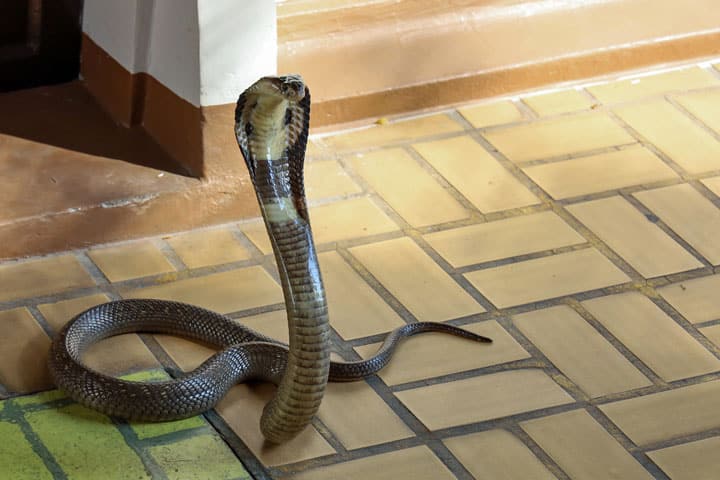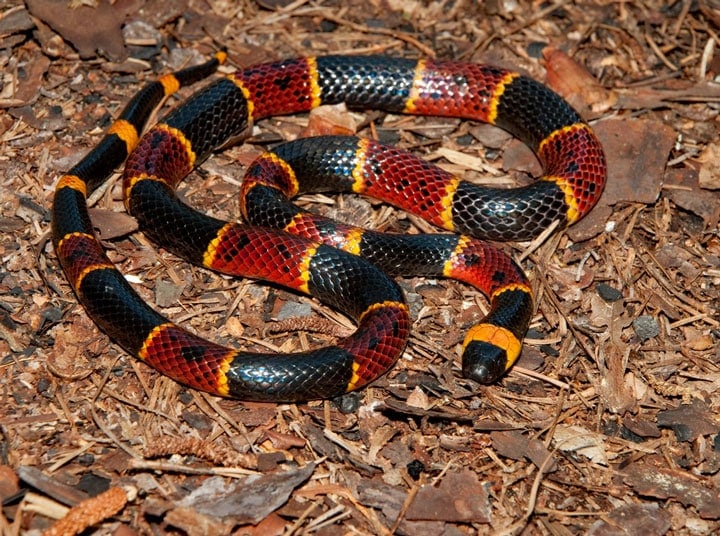25 venomous and non-venomous snakes in Thailand

Cobra
There are about 200 species of snakes found in Thailand, including both venomous and non-venomous snakes. The exact number of snakes living in Thailand is difficult to determine because snakes are often difficult to detect and because snake populations can fluctuate depending on factors such as climate and food availability.
The venomous snakes that occur in Thailand include cobras, coral snakes, piton snakes and smooth snakes. The non-venomous snakes you can find in Thailand include ground snakes, bamboo snakes and green tree snakes.
While most snakes in Thailand are non-venomous, it's important to take care when traveling in the rainforest or other areas of Thailand and to seek professional advice if you see a snake. Snakes are important to the ecosystem and play an important role in helping to balance the population of insects and other prey.
We mention a few well-known snake species that occur in Thailand:
- Coral snake: This snake is easily identified by its distinctive red, orange, and black colors. It is a poisonous snake that lives in the rainforest and on the slopes of the mountains.
- Cobra: The cobra is one of the most famous snakes in Thailand and is often associated with the traditional art of snake charm. It is a venomous snake found in rainforests and urban areas.
- piton snake: The piton snake is a large, poisonous snake that lives in the rainforest and in the hilly areas of Thailand. It has a striking, dark brown color with black spots.
- Bamboo snake: The bamboo snake is a non-venomous snake found in the rainforest and hilly areas of Thailand. It has a striking, green-brown color and can grow up to 2 meters in length.
- Soil hose: The ground snake is a non-venomous snake found in the rainforest and hilly regions of Thailand. It has a striking, dark brown color with yellow spots.
25 venomous and non-venomous snakes in Thailand
| Poisonous snakes | Non-venomous snakes |
|---|---|
| 1. King Cobra | 1. Reticulated Python |
| 2. Malaysian Krait | 2. Burmese Python |
| 3. Monocled Cobra | 3. Common Sand Boa |
| 4. Russell's Viper | 4.Green Cat Snake |
| 5. Siamese Spitting Cobra | 5.Brahminy Blind Snake |
| 6. Eastern Coral Snake | 6. Sunbeam Snake |
| 7. Banded Krait | 7. Indian Wolf Snake |
| 8. White-Lipped Pit Viper | 8. Flower's Rat Snake |
| 9. Red Headed Krait | 9.Oriental Rat Snake |
| 10. Malayan Pit Viper | 10. Painted Bronzeback |
| 11. Many Banded Krait | 11. Common Mock Viper |
| 12.Blue Krait | 12. Keeled Rat Snake |
| 13. Big Eyed Pit Viper | 13. Striped Kukri Snake |
| 14. Sumatran Spitting Cobra | 14. Twin Barred Tree Snake |
| 15. Green Pit Viper | 15.Buff Striped Keelback |
| 16.Black Pit Viper | 16. Indochinese Rat Snake |
| 17. Wagler's Pit Viper | 17. Checkered Keelback |
| 18. Siamese Russell's Viper | 18. Banded Kukri Snake |
| 19. Cantor's Pit Viper | 19.Oriental Whip Snake |
| 20. Mangrove Pit Viper | 20.Common Bronzeback |
| 21.King Cobra | 21. Common Wolf Snake |
| 22. Bungarus Fasciatus | 22. Speckle-Bellied Keelback |
| 23. Equatorial Spitting Cobra | 23. Radiated Rat Snake |
| 24. Naja Kaouthia | 24. Red Tailed Pipe Snake |
| 25. Trimeresurus Albolabris | 25. Banded Flying Snake |
It is important to remember that touching or trying to catch snakes is illegal in Thailand and can lead to dangerous situations. If you see a snake while traveling in Thailand or in your garden, keep your distance and consult an expert to remove it.

Coral snake


Useful to know. The snakes listed are striking species that are so striking because they signal "stay away from me". An evolutionary development that made them survive as a species.
The most dangerous snakes in Thailand are the so-called pitvipers – I don't know the Dutch name.
Around my house in Naklua, Soi 16, on the stretch of forest between that soi and soi 14 Naklua, I found one of the most venomous, the Malaysian pit viper. These species are brown, very dark green, or gray-black.
Most snakes run away when they feel the vibrations of an approaching animal. The pitvipers just lie there and wait for you to get close enough.
In an encounter signaled to me by one of the stray dogs that I had domesticated to guard my house (they eat from your hand and defend "their" territory in an aggressive pack) I was also able to determine that when they are aggressive they also move half a meter at lightning speed can shoot with mouth wide open. I saw that when I threw a rock in the direction of the snake while my dog was watching from a distance.
Incidentally, these species hunt frogs, all kinds of rodents, chicks from the nest, etc. and they came under my house to drink from a bowl of water that I had placed there.
Another species perhaps called bamboo snake (the description above is related to 2 species) by the Thai is a culture follower: it feeds near houses – a Thai style outdoor kitchen with vegetable waste etc. for example – with the cockroaches and other vermin . This yellow-green, very thin snake crawled up to my house through a hole in an aluminum sink valve. This snake is kept as a pet by the Thais and escapes regularly. I have seen them on 2nd road in front of the Bangkok Bank office opposite Soi 6 while standing at an ATM machine. This snake and all snakes in general are fond of electromagnetic waves - which stimulate an organ in front of the brain. Because she is so thin she likes to crawl between the electricity wires in the house and then lives between the concrete and the plaster of your living room ceiling. This was an incident in Cha-am where food scraps are thrown everywhere by Thai bathers: in one day I had them 4 times in the house. The latter had wrapped itself around an old-fashioned TV.
This snake is poisonous, although most Thais do not know that. The fangs are very deep in the mouth and only when bitten with a very wide open mouth can she inject poison. Incidentally, I was warned by the Thais - I had killed the last of the 4 when she started to climb into a corner of the room on her way to a hole where she could then escape onto the ceiling. There is another slightly thicker but shorter snake that is very similar to the so-called bamboo snake.
An absolute contraindication is walking through a bamboo forest, as far as it is at a distance from houses. One of my jobs took me to a province on the Burmese border where there are many real bamboo forests on the stony hills. It was swarming with snakes there; according to the Thais, this is because there are many rodents that eat the shoots of bamboo. Just buy your shoots in the local market because a free shoot can break acid!
The pit viper is called the pit viper in our language.
In the beginning of the rainy season (May-June) most bites occur, including Malayan Pit Vipers.
The bamboo snake (white-lipped bamboo viper) is also a nice link, all vipers secrete a poison that works as a neurotoxin, among other things, no immediate treatment can have a fatal outcome.
Do you have a picture of such a venomous 'Piton' snake in your editorial office?
I don't know this species yet. And the pit viper is not the most dangerous. Those are the monocled cobras and kraits.
There are various snake recognition groups on facebook, such as “snakes of huahin”.
Is there a snake in your house or garden, and you don't know what kind of snake it is or what to do with it, you can post a photo / report in these types of groups.
Currently it is rainy season. It seems that the Malasian Pit Viper is now widely seen.
That pit viper is indeed a bitch. Because of my bushmower, that beast flew half a meter in front of me through the air. Then immediately launch an attack upon landing. Again be careful when mowing!
Especially in places where it is shady, leaves and possibly. fruits lie. Great area for a pit viper, after all, small animals also come to it, which in turn is its meal.
I think there are some serious inaccuracies/incompleteness here!
Moreover, what is a Piton snake?
Never heard of it, unless a Python is meant, which is non-venomous.
“Fangs in the back of the ?mouth”?
This is called ophistoglyph and usually these venomous snakes are too small to inject an adult human, unless they bite you in thinner parts of the body (eg little finger).
You should be most wary in Asia for yellow Kraits (although they don't bite easily) and Vipers (Vipers)!
Antidotes are easy to get for Cobras, unlike antidotes for Kraits…